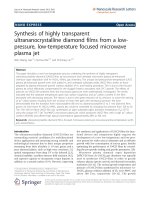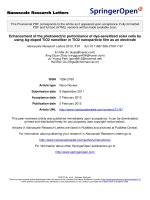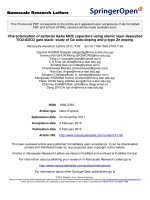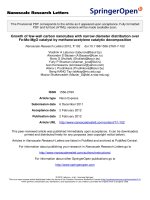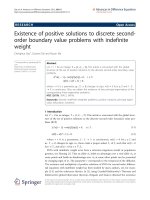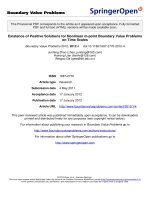Báo cáo toán học: " Nonexistence of positive solutions of an integral system with weights" pdf
Bạn đang xem bản rút gọn của tài liệu. Xem và tải ngay bản đầy đủ của tài liệu tại đây (268.15 KB, 20 trang )
This Provisional PDF corresponds to the article as it appeared upon acceptance. Fully formatted
PDF and full text (HTML) versions will be made available soon.
Nonexistence of positive solutions of an integral system with weights
Advances in Difference Equations 2011, 2011:61 doi:10.1186/1687-1847-2011-61
Zhengce Zhang ()
ISSN 1687-1847
Article type Research
Submission date 17 August 2011
Acceptance date 7 December 2011
Publication date 7 December 2011
Article URL />This peer-reviewed article was published immediately upon acceptance. It can be downloaded,
printed and distributed freely for any purposes (see copyright notice below).
For information about publishing your research in Advances in Difference Equations go to
/>For information about other SpringerOpen publications go to
Advances in Difference
Equations
© 2011 Zhang ; licensee Springer.
This is an open access article distributed under the terms of the Creative Commons Attribution License ( />which permits unrestricted use, distribution, and reproduction in any medium, provided the original work is properly cited.
Nonexistence of positive solutions of an integral system with weights
Zhengce Zhang
School of Mathematics and Statistics, Xi’an Jiaotong University,
Xi’an, 710049, People’s Republic of China
Email address:
Abstract In this article, we study nonexistence, radial symmetry, and monotonic-
ity of the positive solutions for a class of integral systems with weights. We use a
new type of moving plane method introduced by Chen–Li–Ou. Our new ingredient
is the use of Hardy–Littlewood–Sobolev inequality instead of Maximum Principle.
Our results are new even for the Laplace case.
2010 MSC: 35J99; 45E10; 45G05.
Keywords: integral system; moving plane method; nonexistence; radial symmetry
and monotonicity.
1. Introduction
In this article, we study positive solutions of the following system of integral equa-
tions in R
N
(N ≥ 3),
(1.1)
u(x) =
R
N
v(y)
q
|y|
ξ
|x − y|
N−α
dy,
v(x) =
R
N
u(y)
p
|y|
η
|x − y|
N−α
dy,
1
2
with ξ, η < 0, 0 < α < N, 1 < p ≤
N
+
α
−
η
N−α
and 1 < q ≤
N
+
α
−
ξ
N− α
. Under certain
restrictions of regularity, the non-negative solution (u, v) of (1.1) is proved to be trivial
or radially symmetric with respect to some point of R
N
respectively.
The integral system (1.1) is closely related to the system of PDEs in R
N
(1.2)
(−∆)
α/2
u =
v
q
|x|
ξ
,
(−∆)
α/2
v =
u
p
|x|
η
.
In fact, every positive smooth solution of PDE (1.2) multiplied by a constant sat-
isfies (1.1). This equivalence between integral and PDE systems for α = 2 can be
verified as in the proof of Theorem 1 in [1]. For single equations, we refer to [2, The-
orem 4.1]. Here, in (1.2), the following definition is used.
(−∆)
α/2
u = (|χ|
α
u
∧
)
∨
where ∧ is the Fourier transformation and ∨ its inverse.
When α = 2, Figueiredo et al. [3] studied the system of PDEs (1.2) in a bounded
smooth domain Ω with Dirichlet boundary conditions. They found a critical hyper-
bola, given by
(1.3)
N − ξ
q + 1
+
N − η
p + 1
= N − 2, p, q > 0.
Below this hyperbola they showed the existence of nontrivial solutions of (1.2). Inter-
estingly, this hyperbola is closely related to the problem (1.2) in the whole space. For
α = 2 and ξ, η = 0, i.e., the elliptic systems without weights in R
N
, Serrin conjectured
that (1.2) has no bounded positive solutions below the hyperbola of (1.3). It is known
3
that above this hyperbola, (1.2) has positive solutions. Some Liouville type results
were shown in [4, 5] (see also [6, 7]).
When α = 2 and ξ, η ≤ 0, Felmer [8] proved the radial symmetry of the solutions of
the corresponding elliptic system (1.2) by the moving plane method which was based
on Maximum Principle, going back to Alexandroff, Serrin [9], and Gidas et al. [10].
For ξ, η > 0, Chen and Li [11] proved the radial symmetry of solutions of (1.1) on
the hyperbola (1.3). In the special case, when ξ, η = 0, the system (1.1) reduces to
(1.4)
u(x) =
R
N
v(y)
q
|x − y|
N−α
dy,
v(x) =
R
N
u(y)
p
|x − y|
N− α
dy.
The integral system (1.4) is closely related to the system of PDEs
(1.5)
(−∆)
α/2
u = v
q
,
(−∆)
α/2
v = u
p
.
Recently, using the method of moving planes, Ma and Chen [12] proved a Liouville-
type theorem of (1.4), and for the more generalized system,
(1.6)
u(x) =
R
N
v(y)
q
|x − y|
N−α
dy,
v(x) =
R
N
u(y)
p
|x − y|
N− β
dy.
Huang et al. [13] proved the existence, radial symmetry and monotonicity under some
assumptions of p, q, α, and β. Furthermore, using Doubling Lemma indicated in [14],
which is an extension of an idea of Hu [15], Chen and Li [16, Theorem 4.3] obtained the
nonexistence of positive solutions of (1.4) under some stronger integrability conditions
4
(e.g., u, v ∈ L
∞
loc
are necessary). In fact, for System (1.5) of α = 2, Liouville-type
theorems are known for (q, p) in the region [0,
N+2
N−2
] × [0,
N+2
N−2
]. For the interested
readers, we refer to [17,18] and their generalized cases [19,20], where the results were
proved by the moving plane method or the method of moving spheres which both
deeply depend on Maximum Principle. In [21], Mitidieri proved that if (q, p) satisfies
(1.7)
1
p + 1
+
1
q + 1
>
N − 2
N
, p, q > 0,
then System (1.5) possesses no nontrivial radial positive solutions. Later, Mitidieri
[22] showed that a Liouvillle-type theorem holds if (q, p) satisfies
N − 2
N
≤ max
q + 1
qp − 1
,
p + 1
qp − 1
,
generalizing a work by Souto [23]. In [24], Serrin and Zou proved that for (q, p)
satisfying (1.7), there exists no positive solution of System (1.1) when the solution
has an appropriate decay at infinity.
When α = 2, it has been conjectured that a Liouville-type theorem of System
(1.5) holds if the condition (1.7) holds. This conjecture is further suggested by the
works of Van der Vorst [25] and Mitidieri [21] on existence in bounded domains,
Hulshof and Van der Vorst [26], Figueiredo and Felmer [6] on existence on bounded
domains through variational method, and Serrin and Zou [27] on existence of positive
radial solutions when the inequality in (1.7) is reversed. Figueierdo and Felmer [17],
Souto [28], and Serrin and Zou [24] studied System (1.5) and obtained some Liouville-
type results. Ma and Chen [12] gave a partial generalized result about their work.
Serrin conjectured that if (q, p) satisfies (1.7), System (1.5) has no bounded positive
5
solutions. It is known that outside the region of (1.7), System (1.5) has positive
solutions. We believe that the critical hyperbola in the conjecture is closely related
to the famous Hardy–Littlewood–Sobolev inequality [29] and its generalization. For
more results about elliptic systems, one may look at the survey paper of Figueierdo
[30].
There are some related works about this article. When u(x) = v(x) and q = p =
N+α
N−α
, System (1.4) becomes the single equation
(1.8) u(x) =
R
N
u(y)
N+α
N−α
|x − y|
N−α
dy, u > 0 in R
N
.
The corresponding PDE is the well-known family of semilinear equations
(1.9) (−∆)
α/2
u = u
N+α
N−α
, u > 0 in R
N
.
In particular, when N ≥ 3 and α = 2, (1.9) becomes
(1.10) −∆u = u
N+2
N−2
, u > 0 in R
N
.
The classification of the solutions of (1.10) has provided an important ingredient in
the study of the well-known Yamabe problem and the prescribing scalar curvature
problem. Equation (1.10) was studied by Gidas et al. [31], Caffarelli et al. [32], Chen
and Li [33] and Li [34]. They classified all the positive solutions. In the critical case,
Equation (1.10) has a two-parameter family of solutions given by
(1.11) u(x) =
c
d + |x − x|
2
N−2
2
,
6
where c = [N(N − 2)d]
1
2
with d > 0 and x ∈ R
N
. Recently, Wei and Xu [35]
generalized this result to the solutions of the more general Equation (1.9) with α
being any even number between 0 and N.
Apparently, for other real values of α between 0 and N, (1.9) is also of practical
interest and importance. For instance, it arises as the Euler-Lagrange equation of the
functional
I(u) =
R
N
|(−∆)
α
4
u|
2
dx/
R
N
|u|
2N
N−α
dx
N−α
N
.
The classification of the solutions would provide the best constant in the inequality
of the critical Sobolev imbedding from H
α
2
(R
N
) to L
2N
N−α
(R
N
):
R
N
|u|
2N
N−α
dx
N−α
N
≤ C
R
N
|(−∆)
α
4
u|
2
dx.
Let us emphasize that considerable attention has been drawn to Liouville-type
results and existence of positive solutions for general nonlinear elliptic equations and
systems, and that numerous related works are devoted to some of its variants, such
as more general quasilinear operators and domains, and the blowup questions for
nonlinear parabolic equations and systems. We refer the interested reader to [20,22,
26, 27, 36–39], and some of the references therein.
Our results in the present article can be considered as a generalization of those
in [8,12, 17, 18]. We note that we here use the Kelvin-type transform and a new type
of moving plane method intro duced by Chen-Li-Ou, and our new ingredient is the use
of Hardy–Littlewood–Sobolev inequality instead of Maximum Principle. Our results
are new even for the Laplace case of α = 2.
7
Our main results are the following two theorems.
Theorem 1.1. Let the pair (u, v) be a non-negative solution of (1.1) and
N−η
N−α
< p ≤
N+α−η
N−α
,
N−ξ
N− α
< q ≤
N+ α−ξ
N− α
with ξ, η < 0 and 0 < α < N, but p =
N+α−η
N−α
and
q =
N+α−ξ
N− α
are not true at the same time. Moreover, assume that u ∈ L
β
loc
(R
N
) and
v ∈ L
φ
loc
(R
N
) with β =
p−1
(N−α)p+η
N
−1
and φ =
q−1
(N−α)q+ξ
N
−1
. Then both u and v are trivial,
i.e., (u, v) = (0, 0).
Theorem 1.2. Let the pair (u, v) be a non-negative solution of (1.1) and p =
N+α−η
N−α
, q =
N+α−ξ
N−α
with ξ, η < 0 and 0 < α < N. Moreover, assume that u ∈ L
β
loc
(R
N
) and
v ∈ L
φ
loc
(R
N
) with β =
(2α−η)N
α(N−α)
and φ =
(2α−ξ)N
α(N− α)
. Then, u and v are radially symmet-
ric and decreasing with respect to some point of R
N
.
Remark 1.1. Due to the technical difficulty, we here only consider the nonexistence
and symmetry of positive solutions in the range of ξ, η < 0, p >
N−η
N−α
and q >
N−ξ
N− α
.
For ξ, η > 0, Chen and Li [11] proved the radial symmetry of solutions of (1.1) on
the hyperbola (1.3). For ξ = η = 0 and max{1, 2/(N − 2)} < p, q < ∞, Chen and
Li [16, Theorem 4.3] obtained the nonexistence of positive solutions of (1.1) under
some stronger integrability conditions (e.g., u, v ∈ L
∞
loc
are necessary). We note that
there exist many open questions on nonexistence and symmetry of positive solutions of
the equation with weights as (1.1) in the rest range of p, q, ξ, and η. It is an interesting
research subject in the future.
8
We shall prove Theorem 1.1 via the Kelvin-type transform and the moving plane
method (see [2, 40,41]) and prove Theorem 1.2 by the similar idea as in [17].
Throughout the article, C will denote different positive constants which depend
only on N, p, q, α and the solutions u and v in varying places.
2. Kelvin-type transform and nonexistence
In this section, we use the moving plane method to prove Theorem 1.1. First, we
introduce the Kelvin-type transform of u and v as follows, for any x = 0,
u(x) = |x|
α−N
u
x
|x|
2
and v(x) = |x|
α−N
v
x
|x|
2
.
Then by elementary calculations, one can see that (1.1) and (1.2) are transformed
into the following forms:
(2.1)
u(x) =
R
N
v(y)
q
|y|
s
|x − y|
N−α
dy,
v(x) =
R
N
u(y)
p
|y|
t
|x − y|
N−α
dy,
and
(2.2)
(−∆)
α/2
u = |x|
−s
v
q
,
(−∆)
α/2
v = |x|
−t
u
p
,
where t = (N + α) − η − (N − α)p ≥ 0 and s = ( N + α) − ξ − (N − α)q ≥ 0.
Obviously, both u(x) and v(x) may have singularities at origin. Since u ∈ L
β
loc
(R
N
)
and v ∈ L
φ
loc
(R
N
), it is easy to see that u(x) and v(x) have no singularities at infinity,
9
i.e., for any domain Ω that is a positive distance away from the origin,
(2.3)
Ω
u(y)
β
dy < ∞ and
Ω
v(y)
φ
dy < ∞.
In fact, for y = z/|z|
2
, we have
Ω
u(y)
β
dy =
Ω
(|y|
α−N
u(
y
|y|
2
))
β
dy
=
Ω
∗
(|z|
N−α
u(z))
β
|z|
−2N
dz
=
Ω
∗
|z|
β(N−α)−2N
u(z)
β
dz
≤ C
Ω
∗
u(z)
β
dz
< ∞.
For the second equality, we have made the transform y = z/|z|
2
. Since Ω is a positive
distance away from the origin, Ω
∗
, the image of Ω under this transform, is bounded.
Also, note that β(N − α) − 2N > 0 by the assumptions of Theorem 1.1. Then, we
get the estimate (2.3).
For a given real number λ, define
Σ
λ
= {x = (x
1
, , x
n
)|x
1
≥ λ}.
Let x
λ
= (2λ − x
1
, x
2
, , x
n
), u
λ
(x) = u(x
λ
) and v
λ
(x) = v(x
λ
).
The following lemma is elementary and is similar to Lemma 2.1 in [2].
10
Lemma 2.1. For any solution (u(x), v(x)) of (2.1), we have
(2.4) u
λ
(x) − u(x) =
Σ
λ
(|x − y|
α−N
− |x
λ
− y|
α−N
)[|y
λ
|
−s
v
λ
(y)
q
− |y|
−s
v(y)
q
]dy
and
(2.5) v
λ
(x) − v(x) =
Σ
λ
(|x − y|
α−N
− |x
λ
− y|
α−N
)[|y
λ
|
−t
u
λ
(y)
p
− |y|
−t
u(y)
p
]dy.
Proof. It is easy to see that
u(x) =
Σ
λ
|y|
−s
|x − y|
α−N
v
q
(y)dy
+
Σ
λ
|y
λ
|
−s
|x
λ
− y|
α−N
v
λ
q
(y)dy.(2.6)
Substituting x by x
λ
, we have
u(x
λ
) =
Σ
λ
|y|
−s
|x
λ
− y|
α−N
v
q
(y)dy
+
Σ
λ
|y
λ
|
−s
|x − y|
α−N
v
λ
q
(y)dy.(2.7)
The fact that |x − y
λ
| = |x
λ
− y| implies (2.4). Similarly, one can show that (2.5)
holds. So, Lemma 2.1 is proved. ✷
Proof of Theorem 1.1.
Outline: Let x
1
and x
2
be any two points in R
N
. We shall show that
u(x
1
) = u(x
2
) and v(x
1
) = v(x
2
)
11
and therefore u and v must be constants. This is impossible unless u = v = 0. To
obtain this, we show that u and v are symmetric about the midpoint (x
1
+ x
2
)/2.
We may assume that the midpoint is at the origin. Let u and v be the Kelvin-type
transformations of u and v, respectively. Then, what left to prove is that u and v are
symmetric about the origin. We shall carry this out in the following three steps.
Step 1. Define
Σ
u
λ
= {x ∈ Σ
λ
|u(x) < u
λ
(x)}
and
Σ
v
λ
= {x ∈ Σ
λ
|v(x) < v
λ
(x)}
We show that for sufficiently negative values of λ, both Σ
u
λ
and Σ
v
λ
must be empty.
Whenever x, y ∈ Σ
λ
, we have that |x − y| ≤ |x
λ
− y|. Moreover, since λ < 0,
|y
λ
| ≥ |y| for any y ∈ Σ
λ
. Then by Lemma 2.1, for any x ∈ Σ
λ
, it is easy to verify
that
u
λ
(x) − u(x) ≤
Σ
λ
(|x − y|
α−N
− |x
λ
− y|
α−N
)|y|
−s
[v
λ
(y)
q
− v(y)
q
]dy
≤
Σ
v
λ
|x − y|
α−N
|y|
−s
[v
λ
(y)
q
− v(y)
q
]dy
≤
Σ
v
λ
|x − y|
α−N
|y|
−s
[v
λ
(y)
q−1
(v
λ
(y) − v(y))]dy.(2.8)
Now we recall the double weighted Hardy–Littlewood–Sobolev inequality which
was generalized by Stein and Weiss [42]:
(2.9)
f(y)
|x|
γ
|x − y|
λ
|y|
τ
dy
q
≤ C
γ,τ,p,λ,N
f
p
,
12
where 0 ≤ τ < N/p
, 0 ≤ γ < N/q and 1/p + (γ + τ + λ)/N = 1 + 1/q with
1/p + 1/p
= 1.
It follows first from inequality (2.9) and then the H¨older inequality that, for any
r > max{(N − ξ)/(N − α ), (N − η)/(N − α)},
u
λ
− u
L
r
(Σ
u
λ
)
≤ C
Σ
v
λ
|x − y|
α−N
|y|
−s
[v
λ
(y)
q−1
(v
λ
(y) − v(y))]dy
L
r
(Σ
v
λ
)
≤ Cv
λ
q−1
L
φ
(Σ
v
λ
)
v
λ
(y) − v(y)
L
r
(Σ
v
λ
)
,(2.10)
where φ =
q−1
(N−α)q+ξ
N
−1
.
Similarly, one can show that
(2.11) v
λ
− v
L
r
(Σ
v
λ
)
≤ Cu
λ
p−1
L
β
(Σ
u
λ
)
u
λ
(y) − u(y)
L
r
(Σ
u
λ
)
,
where β =
p−1
(N−α)p+η
N
−1
.
Combining (2.10) and (2.11), we arrive at
(2.12) u
λ
− u
L
r
(Σ
u
λ
)
≤ Cv
λ
q−1
L
φ
(Σ
v
λ
)
u
λ
p−1
L
β
(Σ
u
λ
)
u
λ
− u
L
r
(Σ
u
λ
)
.
By the integrability conditions ,we can choose M sufficiently large, such that for
λ ≤ −M, we have
(2.13) Cv
λ
q−1
L
φ
(Σ
v
λ
)
u
λ
p−1
L
β
(Σ
u
λ
)
≤
1
2
.
These imply that u
λ
− u
L
r
(Σ
u
λ
)
= 0. In other words, Σ
u
λ
must be measure zero, and
hence empty. Similarly, one can show that Σ
v
λ
is empty. Step 1 is complete.
13
Step 2. Now we have that for λ ≤ −M,
(2.14) u(x) ≥ u
λ
(x) and v(x) ≥ v
λ
(x), ∀x ∈
λ
.
Thus, we can move the plane λ ≤ −M to the right as long as (2.14) holds. Suppose
that at one λ
0
< 0, we have, on
λ
u(x) ≥ u
λ
0
(x) and v(x) ≥ v
λ
0
(x).
But either
meas{x ∈
λ
0
|u(x) > u
λ
0
(x)} > 0
or
meas{x ∈
λ
0
|v(x) > v
λ
0
(x)} > 0.
Then, we want to show that the plane can be moved further to the right, i.e., there
exists an depending on N, p, q and the solution (u, v) such that (2.14) holds on
λ
for all λ ∈ [λ
0
, λ
0
+ ).
Assume that meas{x ∈
λ
0
|v(x) > v
λ
0
(x)} > 0. By (2.4), we know that u(x) >
u
λ
0
(x) in the interior of
λ
0
. Define
u
λ
0
= {x ∈
λ
0
|u(x) ≤ u
λ
0
(x)} and
v
λ
0
=
{x ∈
λ
0
|v(x) ≤ v
λ
0
(x)}. It is clear that
v
λ
has measure zero, and lim
λ→λ
0
u
λ
⊂
u
λ
0
in the sense of measures. The same conclusion holds for v. Let G
∗
be the
reflection of the set G about the plane x
1
= λ. We see from (2.10) and (2.11) that
(2.15) u
λ
− u
L
r
(Σ
u
λ
)
≤ Cv
λ
q−1
L
φ
((Σ
v
λ
)
∗
)
u
λ
p−1
L
β
((Σ
u
λ
)
∗
)
u
λ
− u
L
r
(Σ
u
λ
)
.
14
Again, the integrability of u and v ensures that one can choose small enough, such
that for all λ ∈ [λ
0
, λ
0
+ ),
Cv
λ
q−1
L
φ
((Σ
v
λ
)
∗
))
u
λ
p−1
L
β
((Σ
u
λ
)
∗
))
≤
1
2
.
Now by (2.15) we have
u
λ
− u
L
r
(Σ
u
λ
)
= 0
and therefore Σ
u
λ
is empty. A similar argument shows that Σ
v
λ
is empty too.
Step 3. If the plane stops at x
1
= λ
0
for some λ
0
< 0, then u and v must be
symmetric and monotone about the plane x
1
= λ
0
. This implies that u and v have
no singularity at the origin. But the equations in (2.2) tell us that this is impossible
if u(x) and v(x) are nontrivial. Hence, we can move the plane to x
1
= 0. Then,
u(x) and v(x) are symmetric about the plane origin. Then u = v = 0. The proof of
Theorem 1.1 is complete. ✷
3. Symmetry and monotonicity
In this section, we prove Theorem 1.2 which shows that the non-negative solutions
of System (1.1) are radially symmetric and decreasing with respect to some point in
R
N
.
Proof of Theorem 1.2. We show that u and v are symmetric with respect to some
plane parallel x
1
= 0. Indeed, if λ
0
< 0, such as the steps of Theorem 1.1, we know u
and v are symmetric with respect to the hyperplane x
1
= λ
0
. If λ
0
= 0, we conclude
that u
0
(x) ≥ u(x) and v
0
(x) ≥ v(x) for all x ∈ Σ
0
. On the other hand, we perform the
15
moving plane procedure from the right and find a corresponding λ
r
0
≥ 0. If λ
r
0
> 0,
an analogue to Theorem 1.1 shows that u and v are symmetric with respect to the
hyperplane x
1
= λ
r
0
. If λ
r
0
= 0, we conclude that u
0
(x) ≤ u(x) and v
0
(x) ≤ v(x) for
all x ∈ Σ
0
. From above we can conclude u and v are symmetric with respect to the
plane x
1
= 0. We perform this moving plane procedure taking planes perpendicular
to any direction, and for each direction γ ∈ R
N
, |γ| = 1, we can find a plane T
γ
with
the property that both u and v are symmetric with respect to T
γ
. A simple argument
shows that all these planes intersect at a single point, or u = v = 0. The proof of
Theorem 1.2 is complete. ✷
Competing interests
The author declares that he has no competing interests.
Acknowledgments
We would thank the anonymous referees very much for their valuable corrections
and suggestions. This work was supported by Youth Foundation of NSFC (No.
10701061) and Fundamental Research Funds for the Central Universities of China.
References
[1] Chen, WX, Li, CM: Classification of positive solutions for nonlinear differential and integral
systems with critical exponents, Acta Mathematica Scientia. 29(4), 949–960 (2009)
[2] Chen, WX, Li, CM, Ou, B: Classification of solutions for an integral equation. Comm. Pure
Appl. Math. 59, 330–343 (2006)
16
[3] Figueiredo, DG, Peral, I, Rossi, JD: The critical hyperbola for a Hamiltonian elliptic system
with weights. Annali Matematica. 187, 531–545 (2008)
[4] Cl´ement, Ph, Figueiredo, DG, Mitidieri, E: Positive solutions of semilinear elliptic systems.
Comm. Partial Diff. Equ. 17, 923–940 (1992)
[5] Peletier, LA, Van der Vorst, RCAM: Existence and nonexistence of positive solutions of non-
linear elliptic systems and the Biharmonic equation. Diff. Integral Equ. 5(4), 747–767 (1992)
[6] Figueiredo, DG, Felmer, PL: On superquadratic elliptic systems. Trans. Amer. Math. Soc. 343,
99–116 (1994)
[7] Figueiredo, DG, Ruf, B: Elliptic systems with nonlinearities of arbitrary growth. Mediterr. J.
Math. 1(4), 417–431 (2004)
[8] Felmer, PL: Nonexistence and symmetry theorems for elliptic systems in R
N
. Rendiconti Circolo
Mate. Palermo, Series II, Tomo 40(3), 259–284 (1994)
[9] Serrin, J: A symmetry problem in potential theory. Arch. Rational Mech. Anal. 43, 304–318
(1971)
[10] Gidas, B, Ni, WM, Nirenberg, L: Symmetry and related properties via the maximum principle.
Comm. Math. Phys. 68, 209–243 (1979)
[11] Chen, WX, Li, CM: The best constant in some weighted Hardy–Littlewood–Sobolev inequality.
Proc. AMS, 136, 955–962 (2008)
[12] Ma, L, Chen, DZ: A Liouville-type theorem for an integral system. Comm. Pure Appl. Anal.
5(4), 855–859 (2006)
[13] Huang, XT, Li, DS, Wang, LH: Existence and symmetry of positive solutions of an integral
equation system. Math. Comp. Model. 52, 892–901 (2010)
[14] Polacik, P, Quittner, P, Souplet, P: Singularity and decay estimates in superlinear problems via
Liouville-type theorems, Part I: Elliptic equations and systems. Duke Math. J 139, 555–579 (2007)
[15] Hu, B: Remarks on the blowup estimate for solutions of the heat equation with a nonlinear
boundary condition. Diff. Integ. Equ. 9, 891–901 (1996)
17
[16] Chen, WX, Li, CM: An integral system and the Lane–Emdem conjecture. Disc. Cont. Dyn. Sys.
24(4), 1167–1184 (2009)
[17] Figueiredo, DG, Felmer, PL: A liouvilie-type theorem for systems. Ann. Scuola Norm. Sup.
Pisa. 21(3), 387–397 (1994)
[18] Zhang, ZC, Wang, WM, Li, KT: Liouville-type theorems for semilinear elliptic systems. J.
Partial Diff. Equ. 18(4), 304–310 (2005)
[19] Zhang, ZC, Zhu, LP: Nonexistence and radial symmetry of positive solutions of semilinear
elliptic systems. Disc. Dyn. Nature Soc. 2009(Article ID 629749), 8 (2009)
[20] Zhu, LP, Zhang, ZC, Wang, WM: On the positive solutions for a class of semilinear elliptic
systems. Math. Appl. 19(2), 440–445 (2006)
[21] Mitidieri, E: A Rellich type identity and applications. Comm. PDE. 18, 125–151 (1993)
[22] Mitidieri, E: Nonexistence of positive solutions of semilinear elliptic systems in R
N
. Diff. Integral
Equ. 9(3), 465–479 (1996)
[23] M. A. Souto, Sobre a existˆencia de soluc˜oes positivas para sistemas cooperativos nao linears.
PhD Thesis, UNICAMP (1992)
[24] Serrin, J, Zou, H: Nonexistence of positive solutions of semi-linear elliptic systems. Discourse
Math. Appl. Texas A&M Univ. 3, 56–69 (1994)
[25] Van der Vorst, RCAM: Variational identities and applications to differential systems. Arch.
Rational Mech. Anal. 116, 375–398 (1991)
[26] Hulshof, J, Van der Vorst, RCAM: Differential Systems with strongly indefnite variational
structure. J. Funct. Anal. 114, 32–58 (1993)
[27] Serrin, J, Zou, H: The existence of positive entire solutions of elliptic Hamitonian systems.
Comm. Partial Diff. Equ. 23(3–4), 577–599 (1998)
[28] Souto, MA: A priori estimates and existence of positive solutions of nonlinear cooperative elliptic
systems. Diff. Integral Equ. 8, 1245–1258 (1995)
18
[29] Lieb, E: Sharp constants in the Hardy–Littlewood–Sobolev and related inequalities. Ann. Math.
118, 349–371 (1983)
[30] Figueierdo, DG: Non-linear elliptic systems. Anais Acad. Brasl. Cie. 72(4), 453–469 (2000)
[31] Gidas, B, Ni, WM, Nirenberg, L: Symmetry of positive solutions of nonlinear elliptic equations
in R
N
. In mathematical analysis and applications, Part A. Adv. Math. Suppl. Stud. 7A, pp. 369–
402. Academic Press, New York (1981)
[32] Caffarelli, L, Gidas, B, Spruck, J: Asymptotic symmetry and local behviaior of semilinear elliptic
equations with critical Sobolev growth. Comm. Pure Appl. Math. 42, 271–297 (1989)
[33] Chen, WX, Li, CM: Classification of solutions of some nonlinear elliptic equations. Duke Math.
J 63, 615–622 (1991)
[34] Li, CM: Local asymptotic symmetry of singular solutions to nonlinear elliptic equations. Invent.
Math. 123, 221–231 (1996)
[35] Wei, JC, Xu, XW: Classification of solutions of higher order conformally invariant equations.
Math. Ann. 313, 207–228 (1999)
[36] Chen, SH, Lu, GZ: Existence and nonexistence of positive radial solutions for a class of semi-
linear elliptic system. Nonlinear Anal. 38(7), 919–932 (1999)
[37] Zhang, ZC, Hu, B: Gradient blowup rate for a semilinear parab olic equation. Disc. Cont. Dyn.
Sys. 26, 767–779 (2010)
[38] Zhang, ZC, Guo, ZM: Structure of nontrivial non-negative solutions of singularly perturbed
quasilinear Dirichlet problems. Math. Nachr. 280(13–14), 1620–1639 (2007)
[39] Zhang, ZC, Li, KT: Radial oscillatory solutions of some quasi-linear elliptic equations. Comp.
Math. Appl. 47(8–9), 1327–1334 (2004)
[40] Chen, WX, Li, CM, Ou, B: Classification of solutions for a system of integral equations. Comm.
Partial Diff. Equ. 30, 59–65 (2005)
[41] Chen, WX, Li, CM, Ou, B: Qualitative propertives of solutions for an integral equation. Disc.
Cont. Dyn. Sys. 12, 347–354 (2005)
19
[42] Stein, EM, Weiss, G: Fractional integrals in n-dimensional Euclidean space. J. Math. Mech. 7,
503–514 (1958)

